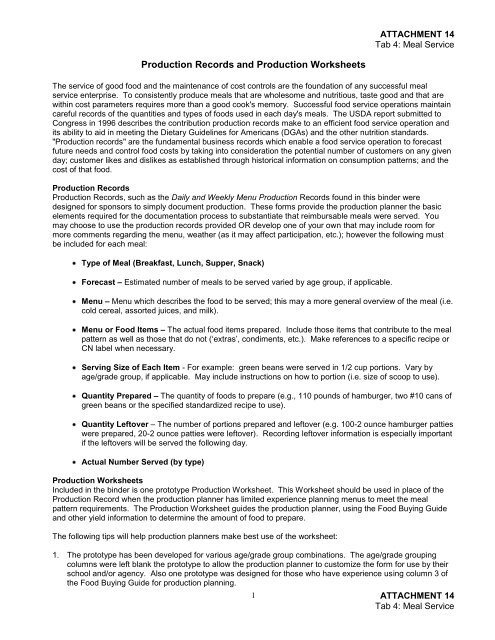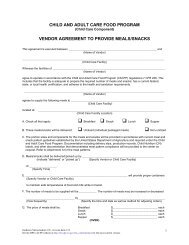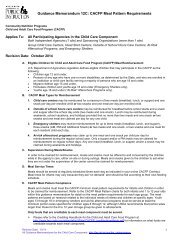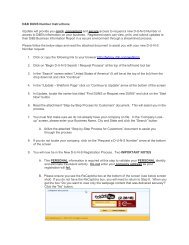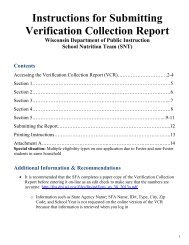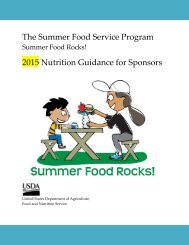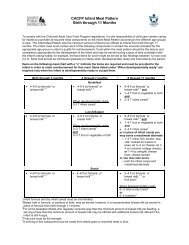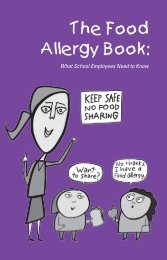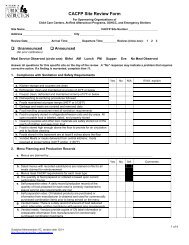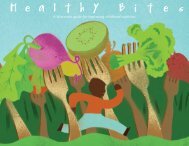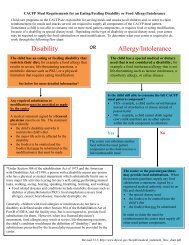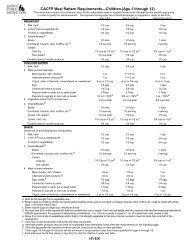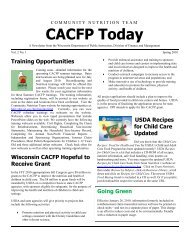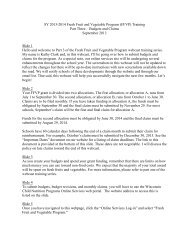Production Record and Production Worksheets - WI Child Nutrition ...
Production Record and Production Worksheets - WI Child Nutrition ...
Production Record and Production Worksheets - WI Child Nutrition ...
You also want an ePaper? Increase the reach of your titles
YUMPU automatically turns print PDFs into web optimized ePapers that Google loves.
ATTACHMENT 14Tab 4: Meal Service<strong>Production</strong> <strong>Record</strong>s <strong>and</strong> <strong>Production</strong> <strong>Worksheets</strong>The service of good food <strong>and</strong> the maintenance of cost controls are the foundation of any successful mealservice enterprise. To consistently produce meals that are wholesome <strong>and</strong> nutritious, taste good <strong>and</strong> that arewithin cost parameters requires more than a good cook's memory. Successful food service operations maintaincareful records of the quantities <strong>and</strong> types of foods used in each day's meals. The USDA report submitted toCongress in 1996 describes the contribution production records make to an efficient food service operation <strong>and</strong>its ability to aid in meeting the Dietary Guidelines for Americans (DGAs) <strong>and</strong> the other nutrition st<strong>and</strong>ards."<strong>Production</strong> records" are the fundamental business records which enable a food service operation to forecastfuture needs <strong>and</strong> control food costs by taking into consideration the potential number of customers on any givenday; customer likes <strong>and</strong> dislikes as established through historical information on consumption patterns; <strong>and</strong> thecost of that food.<strong>Production</strong> <strong>Record</strong>s<strong>Production</strong> <strong>Record</strong>s, such as the Daily <strong>and</strong> Weekly Menu <strong>Production</strong> <strong>Record</strong>s found in this binder weredesigned for sponsors to simply document production. These forms provide the production planner the basicelements required for the documentation process to substantiate that reimbursable meals were served. Youmay choose to use the production records provided OR develop one of your own that may include room formore comments regarding the menu, weather (as it may affect participation, etc.); however the following mustbe included for each meal:Type of Meal (Breakfast, Lunch, Supper, Snack)Forecast – Estimated number of meals to be served varied by age group, if applicable.Menu – Menu which describes the food to be served; this may a more general overview of the meal (i.e.cold cereal, assorted juices, <strong>and</strong> milk).Menu or Food Items – The actual food items prepared. Include those items that contribute to the mealpattern as well as those that do not („extras‟, condiments, etc.). Make references to a specific recipe orCN label when necessary.Serving Size of Each Item - For example: green beans were served in 1/2 cup portions. Vary byage/grade group, if applicable. May include instructions on how to portion (i.e. size of scoop to use).Quantity Prepared – The quantity of foods to prepare (e.g., 110 pounds of hamburger, two #10 cans ofgreen beans or the specified st<strong>and</strong>ardized recipe to use).Quantity Leftover – The number of portions prepared <strong>and</strong> leftover (e.g. 100-2 ounce hamburger pattieswere prepared, 20-2 ounce patties were leftover). <strong>Record</strong>ing leftover information is especially importantif the leftovers will be served the following day.Actual Number Served (by type)<strong>Production</strong> <strong>Worksheets</strong>Included in the binder is one prototype <strong>Production</strong> Worksheet. This Worksheet should be used in place of the<strong>Production</strong> <strong>Record</strong> when the production planner has limited experience planning menus to meet the mealpattern requirements. The <strong>Production</strong> Worksheet guides the production planner, using the Food Buying Guide<strong>and</strong> other yield information to determine the amount of food to prepare.The following tips will help production planners make best use of the worksheet:1. The prototype has been developed for various age/grade group combinations. The age/grade groupingcolumns were left blank the prototype to allow the production planner to customize the form for use by theirschool <strong>and</strong>/or agency. Also one prototype was designed for those who have experience using column 3 ofthe Food Buying Guide for production planning.1ATTACHMENT 14Tab 4: Meal Service
ATTACHMENT 14Tab 4: Meal Service2. Write the menu in the blank provided or paste the menu clipped from another source (e.g., the printed menusent home with children).3. <strong>Record</strong> the “forecasted” <strong>and</strong> actual meal participation in the column provided at the top of the worksheet.4. Use the first column in section A to record the menu items or recipe. Specify the serving size of a portion forthe age/grade groups in the second column.5. Determine the total number of planned portions for each grade grouping based on forecasted participation<strong>and</strong> record this information in section B.6. Convert the serving size from the column(s) in section B to portions listed in the reference that will be usedto calculate total quantity needed. Sources of yield information include the USDA Food Buying Guide, <strong>Child</strong><strong>Nutrition</strong> (CN) labels, <strong>and</strong> product specifications. <strong>Record</strong> the total number of planned portions in section C.7. Use section D to determine the total amount to prepare if this information is unknown. <strong>Production</strong> plannersmay rely on previous records or past practice for this information <strong>and</strong> skip the calculation step. However,the known quantities may not coincide with the planned portion size. The calculations may revealdiscrepancies between the number of servings based on the designated serving size <strong>and</strong> the actual numberof servings prepared. This calculation allows production planners to make appropriate adjustments.8. Use section E to record the amount of food to prepare for each menu item.9. Post the production worksheet in a convenient location for those who prepare <strong>and</strong>/or serve the meal.10. Use the columns in section F to record actual production <strong>and</strong> meal service activity. Space is provided onthe worksheet to record leftover food <strong>and</strong> specify how they will be used.11. Compare the advance plan with actual preparation <strong>and</strong> meal service activity. Some changes may bespecific to a particular day (e.g., inclement weather or a field trip that was not communicated to food servicethat resulted in an excessive amount of leftover food). Use the space at the bottom of the form to makecomments <strong>and</strong> add special instructions. Make adjustments to the master plan for relevant productionchanges.13. Make copies of the completed <strong>and</strong> adjusted worksheet to direct activities for a repeated menu. Use thecopy to capture actual production information <strong>and</strong> save recordkeeping time.2ATTACHMENT 14Tab 4: Meal Service


